After 30 days of 4×4 road trip in Australia , I give you a very complete feedback on this way of traveling. We covered 7000 km in 1 month. It seems a lot but it is quite normal in Australia since the country represents 14 times the size of France. I tried to prepare a complete guide to the Road Trip in Australia with all the practical questions that I asked myself before the trip. And also, all the answers to the organizational problems that we encountered during this family vacation in the heart of the Outback .
Organizing the 4×4 Road Trip in Australia
To prepare a road trip to Australia from France , you will have to go through several important steps:
- define your roadmap : to know my one-month itinerary in Australia >
- Buy a plane ticket: Search for the best flights from France to Australia on search engines.
- Vehicle quote and rental : carefully weigh the pros and cons of each rental company. You must choose the 4×4 rental company that best meets your needs.
- apply for an international driving licence : the international driving licence is free but essential for driving in Australia (please note that it can take up to 7 weeks to obtain the licence).
Australia: Applying for your visa online is more convenient
A trip to Australia requires planning! And when it comes to formalities, we leave nothing to chance. Applying for a visa online saves time and gives you peace of mind. No paperwork, no stress: you receive everything by email, ready to print. A real plus when your head is already in kangaroos and road trips.
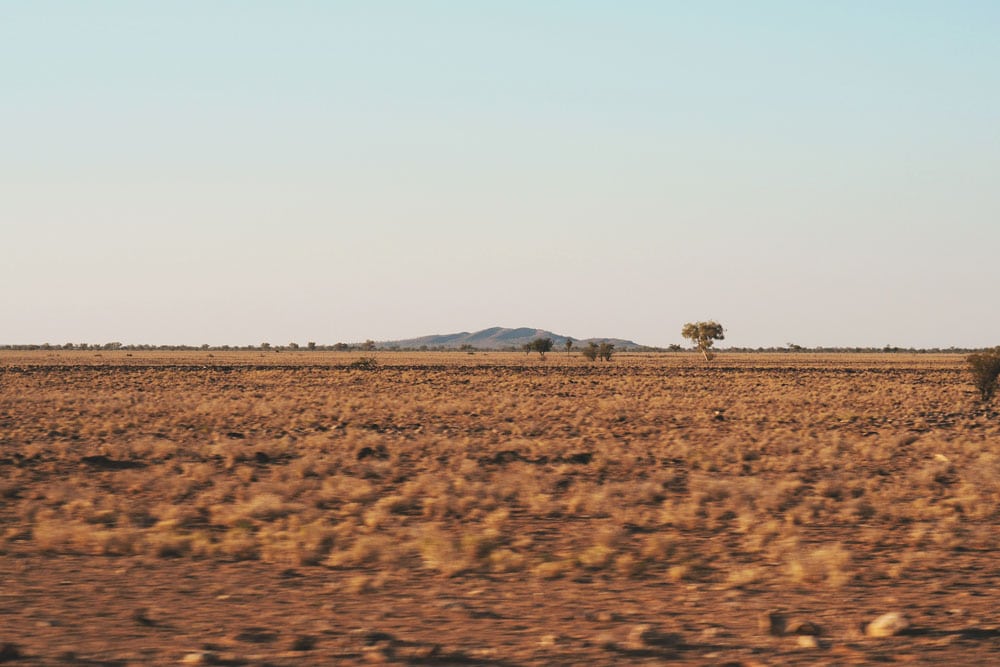
Why travel by 4×4 in Australia?
Australia is such a vast country that to discover it, you will have to drive for long hours , as you will have understood. But the road trip is an authentic experience to live at least once in your life and Australia is the ideal country . Already, by its diversity of landscapes which I told you about in my article covering our entire 1 month itinerary between Northern Territory and Queensland . Then, the roads that crisscross the country offer numerous opportunities for parking for the night . Some countries are hunting down caravanning, take out a folding chair and you will be immediately removed. But in Australia, you will appreciate wild camping . The only living beings that will come to bother you will be the animals. Unless you do not like kangaroos or cockatoos, you can continue reading.
Traveling by 4×4 or Traveling by Van in Australia?
Certainly the car will be much more economical in fuel and rental than a 4×4. But in this case you will have to have a tent with you and run around overcrowded campsites or sleep in more expensive motels . But above all, you can forget about visiting some of the must-see national parks if you do not have a vehicle suitable for driving on tracks . The 4×4 is higher and easily passes through holes and even the gais and other creeks very often encountered in Australia. For example, the wonderful waterfalls of Kakadu Park are, for the most part, several kilometers of chaotic tracks away from the main road. On the other hand, fuel consumption is not a positive argument with 10-15L/100km.
Choosing between a van and a 4×4
Otherwise, if you don’t plan on going on poorly maintained tracks, the van provides more comfort. It’s very pleasant to be able to eat inside, sheltered from the wind and dust because yes, in Australia you will eat dust! Or, stay protected from the cool of the evening and morning, or be spared from mosquitoes and flies in certain areas like around Birdsville. For our part, eating outside has left us with memorable memories close to nature and its atmosphere, whatever the conditions. And that is priceless!
When deciding between a van and a 4×4, you need to consider your destination. If you’re planning to explore the Australian east coast, there’s no need for a 4×4. The west coast and the Northern Territory are best explored with an off-road vehicle. For perfectionists, a 4×4 van is ideal, but it’s expensive and rare.
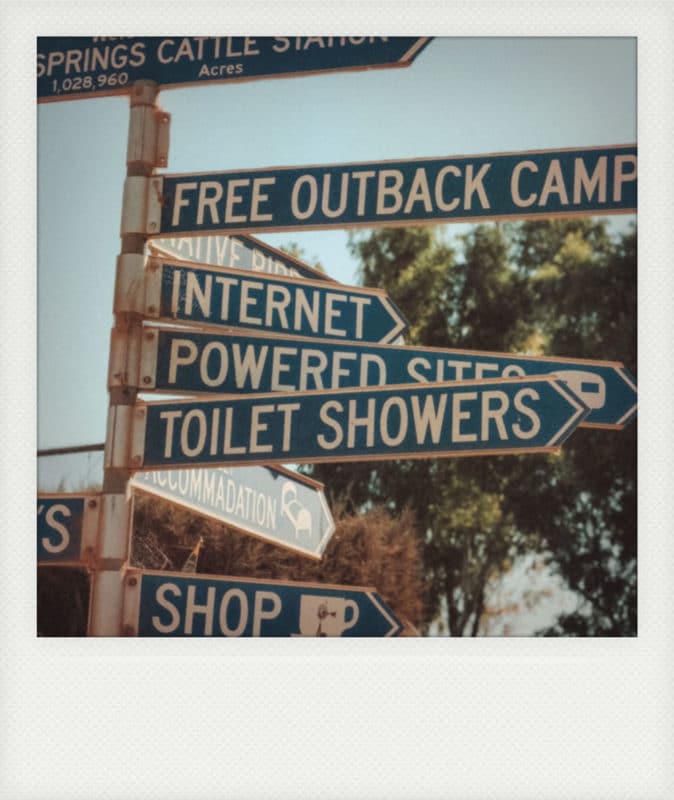
Renting a 4×4 in Australia: How to plan the perfect road trip
Choosing a 4×4 or 4WD is the most important thing to do a few months before your trip. There’s no miracle solution or ready-made solution; it’s up to you to do the research and request quotes based on your needs, your journey, and your arrival and departure destinations in Australia. But I’m going to help you make this choice, so follow along.
Which 4×4 or 4WD rental company in Darwin?
We rented the vehicle from JJJ Car in Darwin , they also have locations in Cairns. Having check-in and check-out in two different cities was one of our essential criteria, which is partly why we chose it.
On the other hand, Hertz offers similar services but they are much more expensive. However, we would have liked to see their 4x4s and the interior layout offered. Indeed, for 1 month, we regret the lack of comfort and the lack of layout of the 4×4 4WD Hire. Which does not mean that we do not recommend them! They are very good value for money for a week trip but beyond that, it becomes really painful to have a basic 4×4 without layout .
I therefore advise you to look at other 4×4 rentals if you are leaving for at least 1 month on the Australian roads . This will allow you to have a quality converted 4×4 . More expensive but more practical.
For your internet research, be aware that in Australia we don’t say 4×4 but awd (all wheel drive) or 4wd (4 wheel drive) .

How to choose a 4×4 rental company in Australia without making a mistake?
Choosing your 4×4 rental company in Australia is a challenge! Especially if you’re planning to rent a 4×4 from France so you can arrive there and be sure to have a 4×4 at your disposal. To give you some essential basics for choosing the right rental company, here’s a list of things to check:
- The prices offered : a rate neither too high for economy, nor too low for safety.
- Rental conditions such as unlimited or very wide mileage, the possibility of using tracks, authorization to go to national parks, etc.
- Ease of communication with the rental company: responsiveness to emails, quick and simple exchange.
- Comprehensive insurance , or almost. Beware of glass breakage , which is very common on the slopes; it is not always covered by rental insurance.
- The vehicle with roof tent and outdoor tent if there are 3 or more of you.
- Camping equipment available : large refrigerator, folding chairs, stove, folding table, set of crockery and cutlery, storage boxes… some equipment is optional, i.e. at an additional cost.
- General consumer opinion on the internet.
And on site you will have to check the conformity of the vehicle, the cleanliness of the engine to detect possible leaks, the condition of the camping equipment and the presence of a tire inflator (very slow and inefficient device but which could save you) or a repair kit…
Equip the 4×4 before setting off on Australian roads
Where to find essential camping gear for a road trip?
You need to equip yourself and do your shopping before setting off on the roads and trails of Australia. Not just food purchases. It’s worth remembering that, given the limited luggage weight, you won’t be able to bring all your camping essentials with you on a plane . And depending on the rental company you choose, the vehicle will only have the camping essentials on board , so you’ll be missing a lot of things. That’s why a trip to the camping supplies store should be factored into your planning.
In Darwin, we found a large shopping area on the Stuart Highway that was perfect for these purchases. Our purchases were: a pot and pan for the stove , a sleeping bag , an extra camping lamp , mosquito repellent … The prices are similar to ours and you have to realize that you won’t be able to take all of that home with you on your return. But a donation at the end of the trip is welcome. Think of Salvos stores as a kind of salvation army. When we left Cairns, we left a whole box of food and dishes with the maid at the Motel. It was she herself who suggested it to us.
Camping equipment stores can be found on the Mapps.me app, look for the ANACONDA sign in Darwin . There is one in the Millner shopping area on the left side of the Stuart Highway as you leave the city centre. To get there, take Bagot Road.
As for the Maps.me app , you should load the maps of Australia by region before your departure or at least when you have sufficient network (preferably wifi).

Organize the 4×4 for more comfort
When it comes to food, you’ll need to think practical. The 4×4’s trunk isn’t expandable, nor is the fridge. Organizing food storage is one of the daily chores of a trip on Australian roads. The Tetris method is self-evident. Don’t hesitate to collect boxes or crates from the first shopping trip to store and organize food . We made themed boxes: breakfast, savory, sweet, dishes, trash… The ideal would be plastic crates with lids or drawer units. But this kind of equipment is only found on more expensive 4x4s. When you’re on a budget road trip , you can find tips.
Please note: Once you’ve packed your camping gear and luggage, there’s very little room left for food. Boxes stack up but don’t always stay in place while traveling on the slopes. Use straps, bungee cords, or, more economically, a strong cord (like a clothesline) to hold all your gear in place.

Equipment, the essentials for a 4×4 road trip
Here is the list of essential items for a successful 4×4 trip :
- Camping chairs
- Camping table
- for a family: folding camp bed + ground tent (the camp bed is also used to relax outside the tent for napping or reading)
- 2-burner portable gas stove and gas bottles (bring several bottles as they are difficult to find on the slopes)
- 1 saucepan, camping dishes (plates, mugs for any liquid, cutlery)
- 1 pan with a removable handle to place it on the embers
- cutting board + 1 efficient knife
- clothespins
- strainer
- clothesline (hanging clothes, holding objects in the 4×4, hanging a lamp from a tree, etc.)
- 2 tea towels + 1 cloth
- paper towels
- 1 sponge and liquid dish soap
- toilet paper
- 2 small basins (laundry, dishes, storage, personal hygiene, etc.)
- 1 shovel
- GPS or Maps.me app
- Cable + iPod for music
- Bestek 1-socket + 2-USB car charger
- Dual USB cigarette lighter socket
- Camping lamp + headlamps
- Inflatable camping cushions
- each 1 warm duvet (nights at 0 degrees in July and August in the Red Center)
- 1 light duvet, also called a sleeping bag (warm nights in the North)
- book or tablet
- a large reserve of drinking water (1 large container and 1 bottle more practical to handle) + a container of running water (for washing dishes, washing hands, etc.)
- a can of gasoline
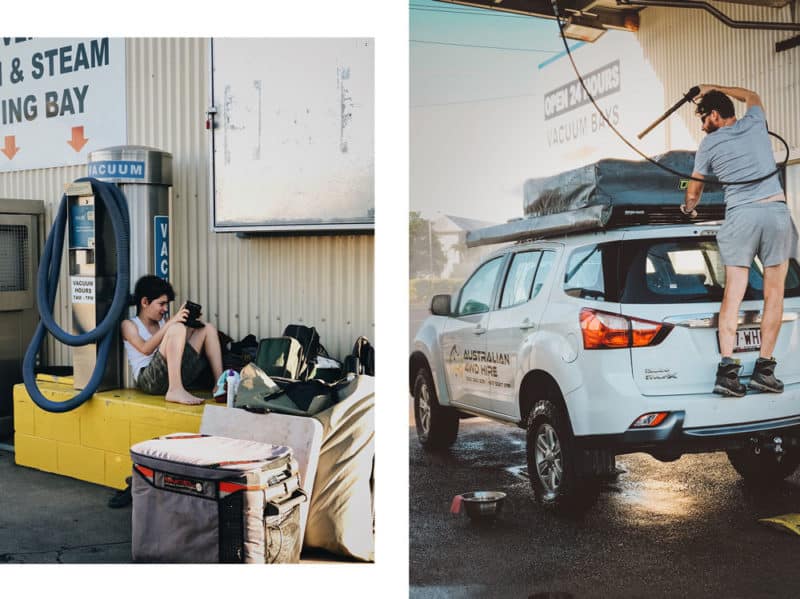
Use the 4×4 roof rack to store luggage
Some things can also fit on the roof of the 4×4 , such as a can of gasoline, a suitcase, camping chairs. But be careful to tie everything down well to avoid the risk of an accident. And be aware that on the slopes, this equipment will be covered in red dust. In addition, each time you have to unfold the roof tent, you will have to remove what is resting on the structure.
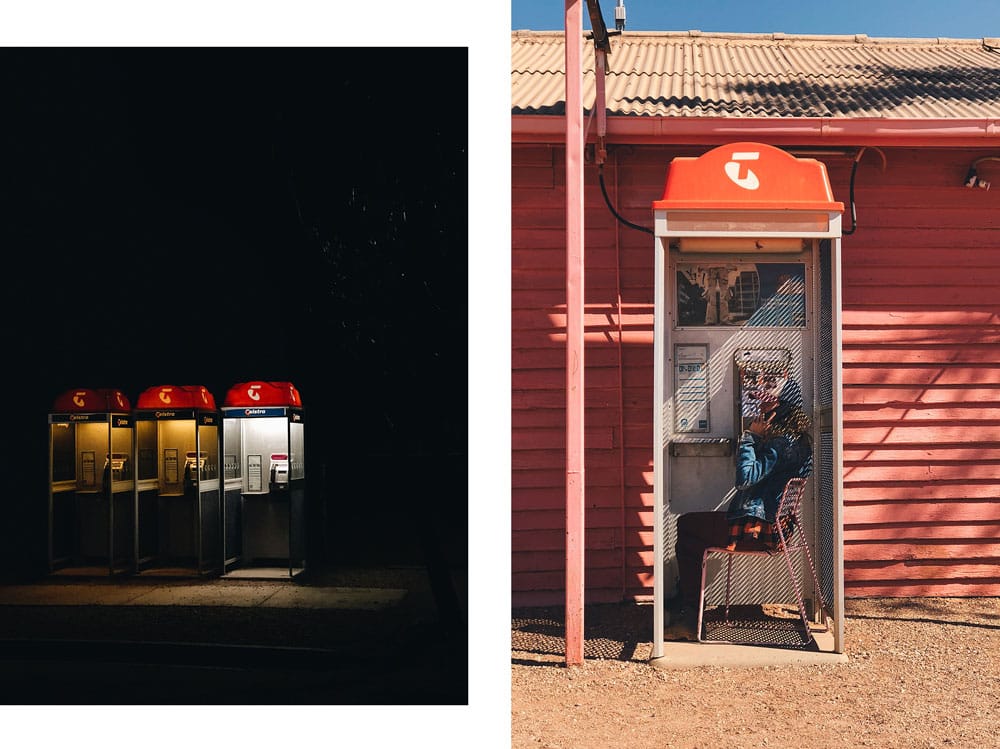
Which phone and internet provider in Australia?
To make calls or have internet on your phone in Australia, consider buying a prepaid card as soon as you arrive in town. As for me, I chose the operator Telstra without doing much research beforehand. I found the store in the Mitchell Centre in Darwin. Telstra is the most widespread internet service provider in Australia . In some very remote areas like the Oodnadatta Track or on the roads going up to Cairns, the only possible telephone network comes from the competitor Opus . So which one to choose? It’s impossible to say, unless you take 2 cards from the 2 providers, and even then, there will still be dead zones .
What are some useful apps for road trips?
- Wikicamp : to find locations for your van or 4×4
- Maps.me : Remember to download the desired maps beforehand; your location is accessible in real time even without an internet or phone network. You can record precise positions and keep them as a reference point to calculate distances.
- Google Translate : Essential for any trip.
- Easy Currency : to know the price of things, it makes the conversion easily.
- WhatsApp : Stay in touch with family and friends even on the other side of the world, and it’s free, provided you have internet.
- Wallet : To keep track of your budget, this app is very useful for keeping accurate and organized accounts, even when you’re abroad.
On a 4×4 road trip, is a fridge essential?
The removable fridge is provided by the rental company. Apart from your luggage and food, this is what will take up the most space in the 4×4 .
And for good reason, a portable fridge for a 4×4 raid is a fairly large trunk that easily takes up a quarter of the rear of the vehicle. This leaves you wondering about the organization of the car. However, despite the winter temperatures of July and August, the days can be very hot and the interior of the car quickly becomes boiling. Therefore, you can imagine the state of your shopping without a fridge . Refusing it when picking up the vehicle from the rental company would be a mistake, just for your cold drinks. I’m not talking about butter, milk, cheese…
On the slopes, dust gets into the cabin, what should I do?
If you have dust saturating the air in your car when driving on Australian tracks, you first need to identify where the dust is coming from.
Contrary to popular belief, it doesn’t come from the ventilation because the dust is raised by the wheels and therefore the air in the vehicle shouldn’t be affected. Look instead at the trunk and the sometimes aging joints. You should see a more marked deposit of ochre earth at the location of the leak. No, I’m not going to tell you to go and change the joint at the garage (unless it’s your own vehicle)…
To temporarily solve the problem (for the duration of your stay), you will use a cloth or any other fabric that you remember to moisten regularly and place at the leak location. And there you have it, that should do the trick! When you return the vehicle, remember to report it to the rental company .
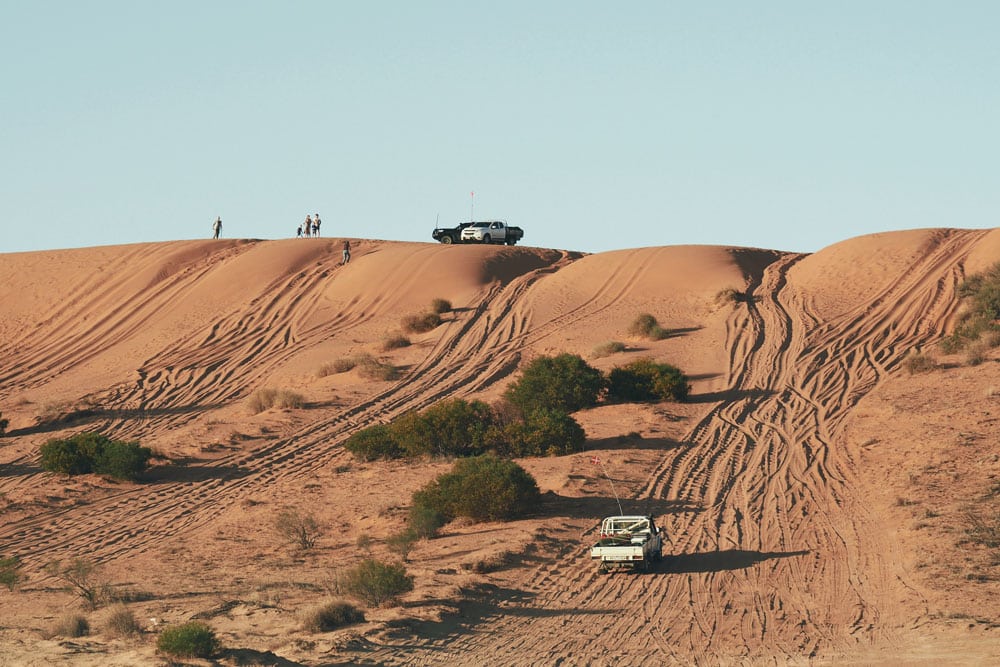
How to charge your gear while on a road trip? How to charge batteries and phones at the same time?
You’re going to the other side of the planet for several weeks, so you’re equipped with photo gear, maybe even video, a phone, an iPod, not to mention a computer. You also need to think about plugging in the fridge, a lamp, and any other electrical equipment you’ll need. Be aware that a phone drains faster when using the GPS function (and you’re going to overdo it). And the fridge is a huge power hog. But how do you recharge all your electrical devices on a road trip? Every problem has a solution, so let’s see how.
Here’s how you can charge all your electrical equipment on board the vehicle:
The vehicle is often equipped with 2 cigarette lighters. One is located at the front, sometimes hidden in the glove compartment. The second is located in the trunk. Thus, you can use the front cigarette lighter for a double or triple USB socket to charge devices used during the trip, such as phones. However, in the back, you can plug in the Bestek converter (which I talk about in the list of essentials) to have a socket and 2 USBs available. It is important to be organized in the charging of each device and to alternate them regularly on the current. On the road and the slopes, do not forget to wedge the equipment being charged on the transformer in the trunk with clothing to prevent it from getting damaged.
And also, a solar charger , replacing the electric charger when not driving, would avoid draining the battery, which is very useful in the fridge.
Save money in Australia
If you’re going on a road trip in Australia, the country being so vast, you’ll be covering a lot of miles. In other words, your budget will be skyrocketing. To help you make this trip a reality, here are some tips and advice that will optimize your travel habits .
Lighten the food budget on a road trip
Food is one of the biggest expenses on a road trip . So to spend as little as possible, shop at supermarkets such as Coles or Woolworth . And preferably buy the store brand, which is often cheaper. Small neighborhood grocery stores will only be useful in an emergency because they are much more expensive. The best-stocked supermarkets in Australia are Woolworths. In this part of Australia, there are almost only these.

How to save money on groceries in Australia?
- shopping in big cities mainly
- stock up by taking batches rather than individually
- buy private label products
- encourage the purchase of pasta, rice, canned goods for the base
Good to know: If your route crosses several states, beware of quarantines . For example, if you’re traveling from Alice Springs to Adelaide, you’ll have to go through customs at Coober Pedy. Customs officers check that you’re not carrying fresh fruit, vegetables, plants, animals… anything that could carry diseases and parasites. South Australia has set up checkpoints across the state . Mobile quarantine barriers also operate on secondary roads. Check beforehand or, if in doubt, stock up on groceries before crossing these borders.
Reduce expenses on accommodation and camping
In Australia, you can find all levels of accommodation. However, the further you go into the national parks, the less choice you will have. The only bar/restaurant often serves as a campsite; it’s a roadhouse. A night in a roadhouse is cheaper than in France , but add it up over a few nights and you’ll have a hefty bill. The secret to lasting is not to overdo it.
Alternate camping types:
Indeed, the best advice I can give you on this subject is to alternate your accommodation options. Whether you’re in a car, van, or 4×4, you’ll have to juggle between wild parking, camping, and motels. Firstly, for a question of price, and secondly, to avoid exhausting yourself in discomfort and ruining the trip.
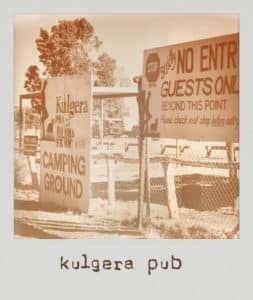
Moderate your comfort requirements
Not only does camping offer all the amenities to enjoy a minimum of comfort , but there is also often Wi-Fi access, even in certain areas without a telephone network. However, this is a service that you will use sparingly to save your money and complete this road trip. Thus, when you visit paying campsites , you will have to optimize your daily tasks . Do your laundry, dry the laundry, do the accumulated dishes, take your shower, apply yourself to a thorough toilet such as shaving, washing your hair… That is to say, everything that you cannot do in wild camping and bivouacs .
Wild camping or road house type camping:
- Wipes, glove, cold water / hot shower
- dishes rinsed in cold water / dishes with sink for spreading and hot water (sometimes only cold)
- wood fire / plancha and barbecue
- disconnection / power outlets possible (in the toilets or at an additional cost when choosing the location)
- toilet in a hole dug in the ground / conventional toilet with paper and flush
- headlamp / toilet and aisle light
- absolute calm / noise from other campers
- wild landscape / view of other campers
- wildlife visit / distracted campers visit
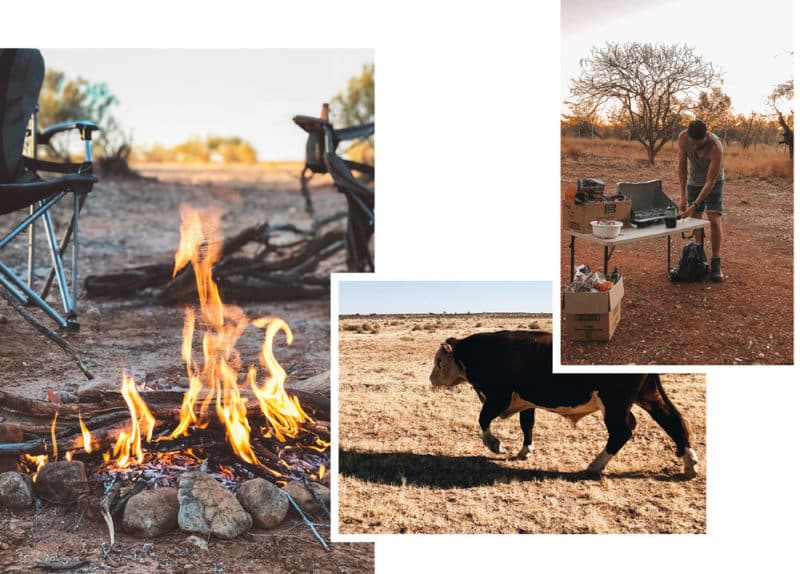
How to save gas in a 4×4?
One way to save on fuel costs is to drive more slowly, below 90 km/h, this will make a difference.
Also, don’t overuse the fuel-hungry 4×4 mode. On long trails, it won’t do much good except drain your fuel reserves more quickly.
What do you eat on a road trip? Grocery shopping in Australia
To continue with the idea of keeping expenses to a minimum , you will eat out as little as possible. Here is a list of what you can eat in Australia by cooking yourself to maintain a balanced diet during these intense weeks.
In the morning at breakfast at the campsite:
It’s very cold in the mornings in Australia during the months of July and August. Breakfast is always accompanied by a hot drink to help you cope with getting out of your warm sleeping bag and facing the lack of positive temperatures.
- Moist cake: There are several types of cake at Woolworths. Plain cake, banana cake, cinnamon cake… Our favorite from this road trip (I’m still salivating): banana cake.
- Muesli with milk: Australians have a huge range of mueslis to suit all tastes.
- Powdered coffee: not great, we fell back on powdered cappuccino.
- Tea: classic choices like in France.
- Sandwich bread and jam.
- Butter: be careful, it’s not real butter like we have at home, it will work in pasta but not really on toast…
Lunch on the Australian slopes:
Our recurring meal during this month of traveling consisted of cheese with crackers and small cherry tomatoes for a starter, a pasta and fresh vegetable salad, and fruit for dessert.
- crackers + Camembert cheese
- tomatoes or cherry tomatoes
- cucumbers, carrots (keep well in the fridge)
- grated mixed vegetables in a bag (keep tightly closed with a clothes peg): fresh cabbage, fennel, carrot, etc.
- Seeds and dried fruits: the best are the Macro Wholefoods Market bags (for example the Tamari Nibble Mix) which are gluten-free and vegan. We also tried the Yummy Fruit and Nut with almonds, goji berries, sunflower seeds, etc.
- lemon, salt and olive oil for the dressing
- fresh onion to chop in the salad
- apples or bananas for dessert
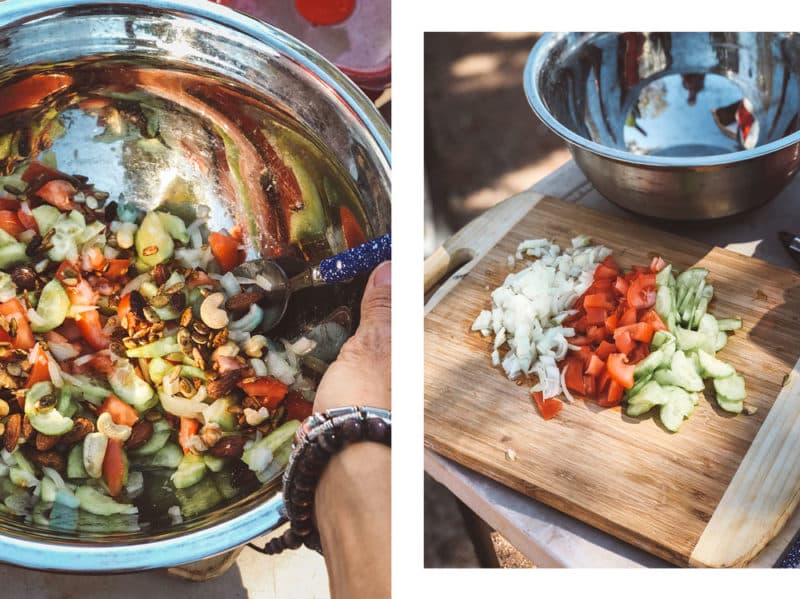
Snack break on the road in Australia:
Taking regular breaks in the car is one of the top rules for a smooth journey, and it’s also a good time to snack.
- yogurt bought in large pots of different flavors: vanilla, raspberry, mango, passion fruit, etc.
- Cereals: The best are Dorset Cereals (berry granola, baked oats with raspberries and blackcurrants) + pecans
- sandwich bread + jam or chocolate spread
- individual juice cartons (handy in the car while driving)
- banana cake (our classic from this trip!)
- blackberry muffins
Evening meal even without comfortable camping:
In the evening, you can afford to have a real hot meal . You have time to make a wood fire or heat up the campsite’s griddle.
- meat on the griddle (griddles are available all over Australia) or in a pan over a wood fire with honey-cooked onions and grilled corn
- pasta with butter and grated cheese (the grated cheese is very far from resembling our Emmental but it remains good with bacon or meat)
- canned tomato sauce or freeze-dried sauce sachets like Maggi but better + cooked sliced onions
- slices of bacon to grill and mix with the pasta
- applesauce
- chocolate squares for dessert

Alcohol in Australia, buying wine or beer
Be careful, in Australia the sale of alcohol is very regulated . You will need to present your ID for any purchase in store. You will not find an alcohol section in the supermarket but a dedicated shop often next to the large store. In the smaller towns of central Australia, buying simple beers will become more complicated or even impossible. Often, the only store in town closes between noon and two. Don’t hesitate to stock up in large cities like Darwin, Alice Springs or Cairns. Failing that, you will go and taste the good atmosphere of an outback pub , which is far from unpleasant.
Shopping in Central Australia
Beyond Alice Springs, heading down to Coober Pedy, you’ll find it harder to find large grocery stores . Fresh produce is scarce in Central Australia. You’ll also pay more. Don’t expect much better from the Oodnadatta Track and the Birdsville Track. On these tracks, the only roadhouse or pub you encounter serves as a grocery store, gas station, and snack bar. It’s that or nothing, for hundreds and hundreds of kilometers.
Monitor the temperature of your fridge
If you’re not driving for more than a day, the car battery won’t be enough to power the fridge. Also, avoid opening the fridge at these times and don’t delay turning it back on, or you’ll lose your food.
4×4 Road Trip Camping in Australia
To sleep on a 4×4 road trip , you will need to know the camping laws in Australia . It is forbidden to wild camp inside National Parks and in cities, and it is punishable by fines. To find good camping spots and bivouac or wild camping options, download the Wikicamp app before you leave.
You will respect nature and preserve the place where you park on a road trip.
– Essential rules for camping in Australia:
We don’t leave anything lying around in free camping or even paid camping so that the wind or animals don’t scatter the rubbish, for example.
To go to the toilet while camping: Move as far away from your campsite as possible and dig a hole, which you don’t forget to cover. This is important, especially to protect animals from disease, like cows that roam freely in deserts.
We check that the campfire does not pose any risk to the surrounding vegetation and we make sure that it is properly extinguished when we leave its surveillance.
When wild camping, don’t be too noisy or intrusive, arrive late and leave early.
Leave the campsite as clean as possible.
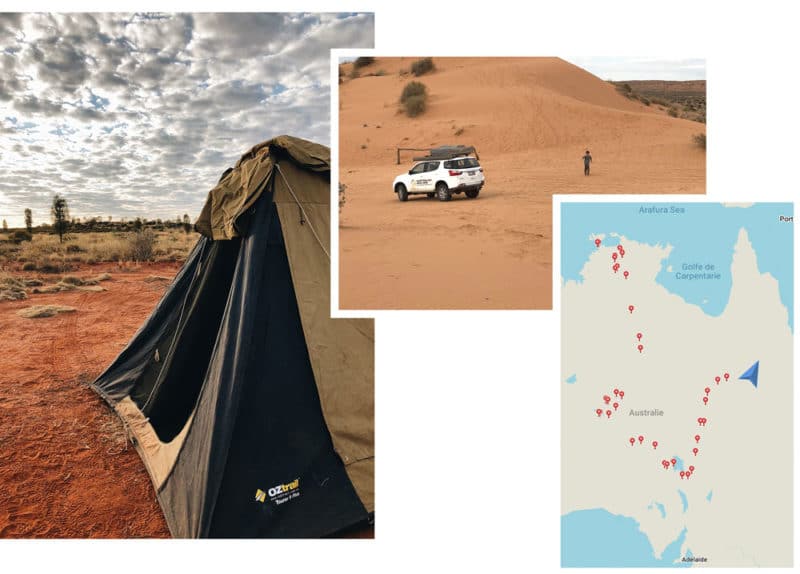
Our personal opinion on the 4×4 with roof tent
In our opinion, and after a month of experience, the 4×4 with a roof tent is not the ideal solution for traveling freely through Australia. I’ll tell you why we were disappointed by this mode of travel. But first, I wanted to point out that being a family, we also had a spare ground tent and 2 folding camp beds and a hammock. This is why we had a good means of comparison on the organization of the camp.
The negative points of the 4×4 with tent
It’s very beautiful and pleasant to be up high, away from animals and the humidity of the ground. As I detail in this article, sleeping in a tent on a 4×4 is very comfortable . But even if it seems practical, this equipment is tedious to set up. If you thought you only had to unfold the tent in one movement, you’d be wrong. The ritual to do every morning and every evening quickly becomes very tedious. Setting up a tent on the ground wouldn’t be more complicated.
An organization that is not always optimal
If you have to travel a few kilometers to reach a site of interest, you will be forced to unpack your entire camp even if you decide to stay several nights in the same campsite. This is the experience we had several times. Having to pack everything up when we returned to the same campsite at the end of the day… rather a waste of time ! For example, the Kings Canyon campsite is quite far from the famous gorges. The same goes for Uluru where access to Australia’s most famous rock is only by car. You will never be able to leave your tent set up and ready to welcome you when you return from hiking. A strong argument when you know the fatigue that accumulates from traveling and visiting in this intensive manner.
A tent not made for winter
The rooftop tent is also too thin and airy for winter temperatures. It doesn’t retain body heat like other, more technical tent models. Furthermore, the rooftop tent takes up all the space on the vehicle’s roof rack; a roof box would be much more practical instead.
In short, what do you think of the roof tent?
For a family of 3, don’t hesitate to rent a large 4×4 with at least 5 seats, otherwise you’ll really be looking for the comfort of campsites more often than you’d hoped.
This is why, if we were to do a family road trip lasting several weeks , we would rent a 4×4 fitted out without a roof tent and two independent tents.


